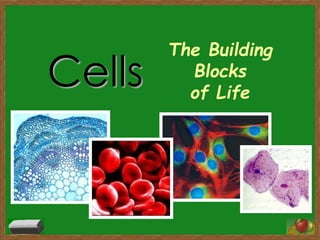
Cells
- 1. Cells The Building Blocks of Life
- 2. Cells Tissues Organs Systems Organism Simple Tissues: Cells of the same type work together to perform a specific function Complex Tissues: Several types of cells work together to perform a specific function Different tissues work together to perform a specific function Several organs working together for a common purpose Various systems work together to form the organism
- 3. Plant Cell Animal Cell
- 4. • Cells observed under the light microscope. Plant Cell Animal Cell
- 5. What are Cells? • Cell Are the basic structural and functional units of life • Cells can exist: – Singly as independent unicellular organisms – Or As part of multicellular organisms
- 6. Multicellular and Unicellular Organisms -Cell Are the basic structural and functional units of life -Some organisms body is made up of single cell that organisms are called : Unicellular Organisms Eg:- Amoeba , Paramecium. -other oraganisms body is made up of more than one cell these organisms are called : multicellular organisms. Eg:- Human Body, different types of animals .
- 7. Cell Structure: (1) Nucleus – The Control Centre Function • Control centre for cell’s activities • Control cell division • Contains genetic materials
- 8. Cell Structure: (2h) Chloroplasts Structure Disc-like structures found in leaf cells Contains a chlorophyll - green pigment Function Carries out photosynthesis Chlorophyll absorbs light energy which is converted to chemical energy
- 9. Cell Structure: (2) Plasma/Cell Membrane Properties • Present in ALL living cells • Made up of fats and proteins • Controls the exchange the substances between the cells and their environment
- 10. Cellulose Cell Wall • Function – Provides shape to the plant cells – Protects cell
- 11. Comparing plant and animal cell Plant Cell Animal Cell 1-Cell wall 2-chloroplast 1-Cell membrane 2-Nucleus 3-cytoplasm 4-vacuole
- 12. Differentiation Red blood cell Nerve cell Xylem vessel cell Muscle cell Epithelial cell Root Hair cell
- 13. nose trachea bronchus lungs Respiratory system Blood circulatory system Takes in oxygen from the surroundings. Releases carbon dioxide and water vapour into the surroundings. Carries food, oxygen and water to various parts of the body and carries wastes away to be removed. Muscular system Enables movement different systems that is found in human
- 14. From Cells to Tissues Within a multicellular organism, Cells of the same type are often arranged in groups to form a simple tissue. Some simple animal tissues are designed to: Move a bone/organ by contraction Protect the structures beneath them Muscle tissue Epithelial tissue
- 15. From Cells to Tissues Within a multicellular organism, Cells of different types can be arranged in groups to form a complex tissue. The different cells work together to perform A SINGLE function. Some complex animal tissues are designed to: Carry electrical impulses Join all parts of the organism Nerve tissue Connective tissue
- 16. From Cells to Tissues Some simple plant tissues are designed to: Protect a plant against injury and drying-out of its inner parts Epidermal tissue Some complex plant tissues are designed to: Vascular tissue Carry out photosynthesis Photosynthetic tissue Transport food and water to various parts of a plant
- 17. From Tissues to Organs • Different tissues in organisms are often grouped together to form an organ. It is responsible for carrying out more complex functions. •Most animal organs (heart, lungs, skin) are made up of connecting tissues and some other specialised tissues. The stomach wall consists of glandular, muscular and connective tissues The heart consist of muscular, blood and connective tissues An organ performs a number of different functions. E.g. Our liver stores food and produces bile.
- 18. From Organs to Systems •Different organs are then linked together to form a body system. •An organism is made up of different systems working effectively individually as well as together in a group. •A number of systems are found in complex organisms to carry out essential bodily functions, such as: - Ensure genetic diversity - Digest food - Eliminate wastes, etc. The functions performed by a body system are more complex than those performed by the organs.
- 19. From Systems to Organisms • Different types of multicellular organisms are made up of different numbers and types of systems. Heart muscle cell (a cell) Heart muscle (a tissue) A group of similar cells that are specialised to perform a certain function together to form a tissues. The heart (an organ) A group of specialised tissues that are gathered in a certain part of the body to perform a particular functions together to form an organ. Circulatory system Various organs that work together to perform a major function in the body to form a system. Different systems work individually, but together, they make up the whole organism.
- 20. Thank you for Listening Done by :Marwa Husni For Tr .: Tessi Class: Seven
